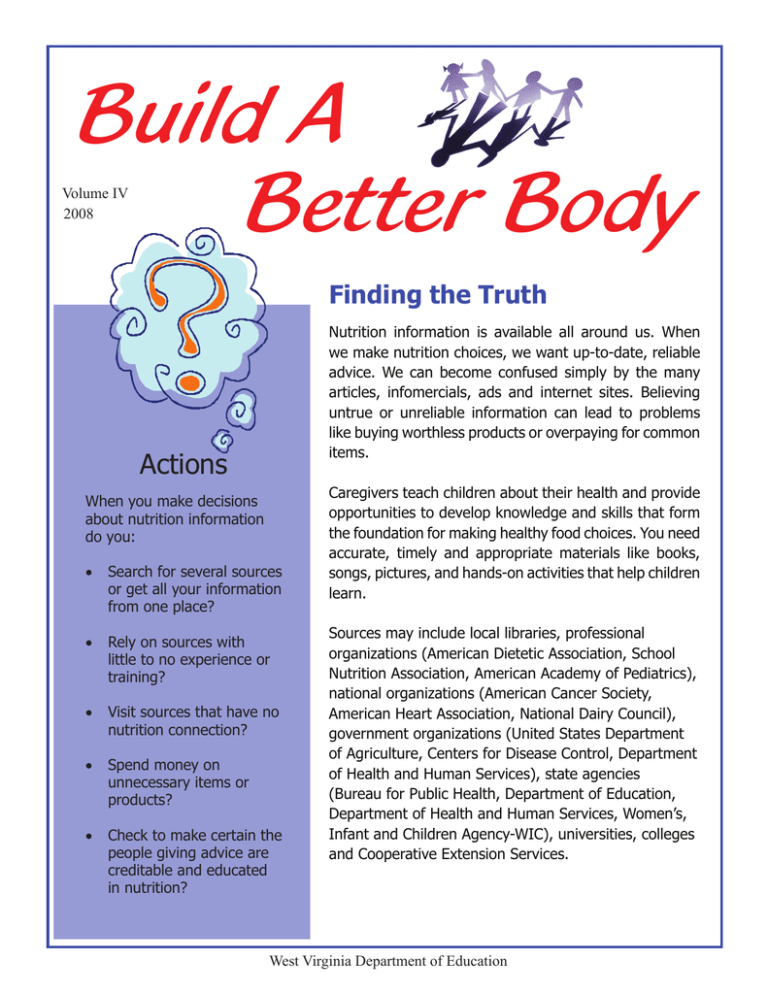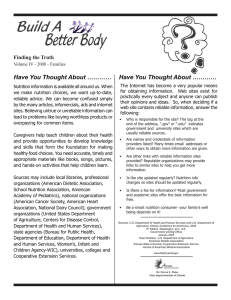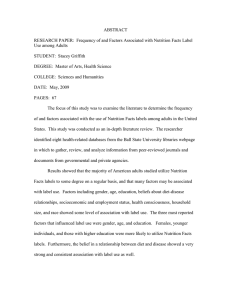Build A Better Body Finding the Truth
advertisement

Build A Better Body Volume IV 2008 Finding the Truth Nutrition information is available all around us. When we make nutrition choices, we want up-to-date, reliable advice. We can become confused simply by the many articles, infomercials, ads and internet sites. Believing untrue or unreliable information can lead to problems like buying worthless products or overpaying for common items. Actions When you make decisions about nutrition information do you: • Search for several sources or get all your information from one place? • Rely on sources with little to no experience or training? • Visit sources that have no nutrition connection? • Spend money on unnecessary items or products? • Check to make certain the people giving advice are creditable and educated in nutrition? Caregivers teach children about their health and provide opportunities to develop knowledge and skills that form the foundation for making healthy food choices. You need accurate, timely and appropriate materials like books, songs, pictures, and hands-on activities that help children learn. Sources may include local libraries, professional organizations (American Dietetic Association, School Nutrition Association, American Academy of Pediatrics), national organizations (American Cancer Society, American Heart Association, National Dairy Council), government organizations (United States Department of Agriculture, Centers for Disease Control, Department of Health and Human Services), state agencies (Bureau for Public Health, Department of Education, Department of Health and Human Services, Women’s, Infant and Children Agency-WIC), universities, colleges and Cooperative Extension Services. West Virginia Department of Education TIP Be skeptical of news stories that • Sound too good to be true; • Use dramatic words like best, longest, most, worst; • Make vague claims or offer cures for many health problems; • Make claims based on testimonials from people rather than refer to actual research; • Offer a quick fix; • Push a product by the person providing the information; • Give examples of foods to avoid or label certain foods ‘bad for you’ or tell you to eliminate an entire food group; and • Offer advice different from the healthy eating guide, MyPyramid. Build A Better Body Remember the Adage ‘If it sounds too good to be true, it probably is too good to be true’. Careful listening and reading will help determine which nutrition information is valid and true. Rely on information from government agencies, nutrition departments of colleges and universities, Cooperative Extension Services, well known medical journals or scientific and professional associations. The Internet has become a very popular means for obtaining information. Web sites exist for practically every subject and anyone can publish their opinions and ideas. So, when deciding if a web site contains reliable information, answer the following: • Who is responsible for the site? The tag at the end of the address, “.gov” or “.edu”, indicates government or university sites which are usually science-based reliable sources. • Are names and credentials of information providers listed? (Examples may include RD- Registered Dietitian, PhDDoctorate degree, MD- Medical Doctor, RN- Registered Nurse, DO- Doctor of Osteopathic Medicine). Many times email addresses or other ways to obtain more information are given, however many web sites list phony journals and meaningless credentials. • Are other links with reliable information sites provided? Reputable organizations may provide links to similar sites to help you get more information. • Is the site updated regularly? Nutrition information changes, so sites should be updated regularly. • Is there a fee for information? Most government and academic sites offer the best information for free. Be a smart nutrition consumer- your well being depends on it! Sources: U.S. Department of Health and Human Services and U.S. Department of Agriculture. Dietary Guidelines for Americans, 2005. 6th Edition, Washington, D.C: U.S. Government printing Office, January 2005. Team Nutrition, U.S. Department of Agriculture American Dietetic Association Kansas State University Cooperative Extension Service Journal of American Medical Association www.mypyramid.gov Build A Better Body NUTRITION TOOL! Pyramid-style Toast Ingredients: 2 eggs ½ cup fat-free milk ½ teaspoon vanilla extract 6 slices whole wheat bread Method: Preheat skillet over medium heat. Put eggs, milk and vanilla in shallow bowl, beat with fork until well mixed. Spray skillet with nonstick cooking spray. Dip bread, one side at a time, into egg mixture. Place in skillet and cook each side until golden brown, approximately 4 minutes per side. Cut into pyramid shapes (triangles). Serve warm with fruit spread. ACTIVITY TOOL! Dancing Pyramids Give children pyramid shaped construction paper. Using food stickers or pictures, ask children to create their personal Pyramid. Then, put on some lively music (Walk like an Egyptian, perhaps) and have them dance with their pyramids, making up their own steps or ones you decide. The idea is to move and have fun! In accordance with federal law and U.S. Department of Agriculture (USDA) policy, this institution is prohibited from discriminating on the basis of race, color, national origin, sex, age, disability or retaliation. If you require information about this program, activity or facility in a language other than English, contact the USDA agency responsible for the program or activity, or any USDA office. If you require this information in alternative format (Braille, large print, audiotape, etc.) contact the USDA’s TARGET Center at (202) 720-2600 (Voice or TDD). To file a complaint of alleging discrimination, write: USDA, Director, Office of Civil Rights; 1400 Independence Avenue, S.W., Washington, D.C. 20250-9410, or call toll free (866) 632-9992 (Voice). TDD users can contact the USDA through local relay or the Federal Relay at (800) 877-8339 (TDD) or (866) 377-8642 (relay voice users). Build A Better Body Finding the Truth Assessment Answer the questions to judge your knowledge of reliable nutrition information. 1. How has your search for information changed since reading this fact sheet? 2. How many of the nutrition sites you visit are marketing a product that is related to the site’s information? Remember sound advice from reliable sources is generally free. 3. Name two nutrition sites you frequently visit. Why do you like those sites? 4. Name two indicators that might lead you to believe the nutrition news you read may not be reliable. 5. Name three likely sources of reliable nutrition information. 6. Check out the web site, www.mypyramid.gov Describe something you found interesting and how you could use that with the children. West Virginia Board of Education 2008-2009 Dr. Steven L. Paine State Superintendent of Schools Delores W. Cook, President; Priscilla M. Haden, Vice President; Jenny N. Phillips, Secretary Robert W. Dunlevy, Member; Barbara N. Fish, Member; Burma Hatfield, Member Lowell E. Johnson, Member; L. Wade Linger, Jr., Member; Gayle C. Manchin, Member Brian E. Noland, Ex Officio; James L. Skidmore, Ex Officio; Steven L. Paine, Ex Officio



